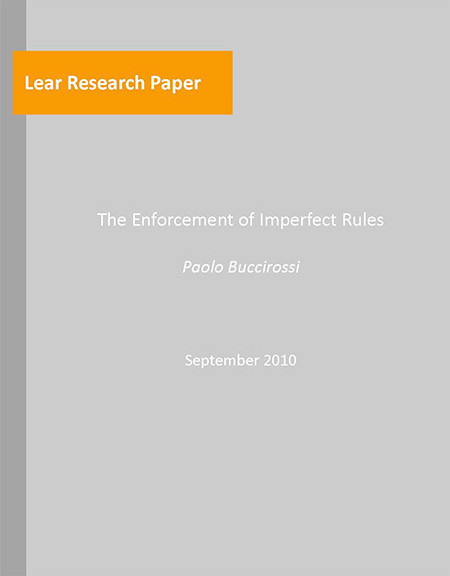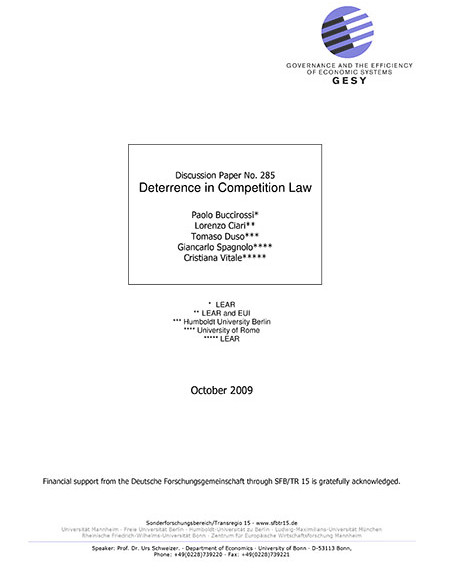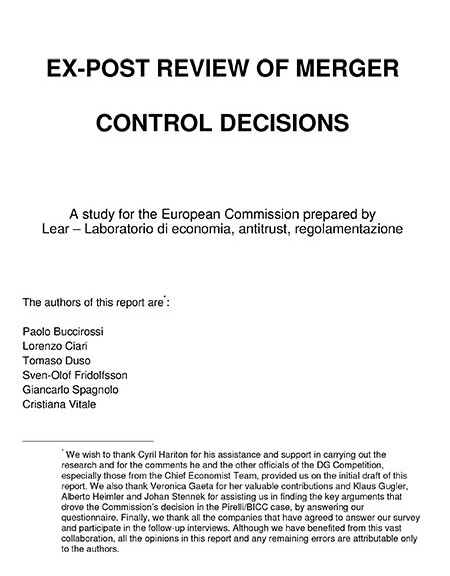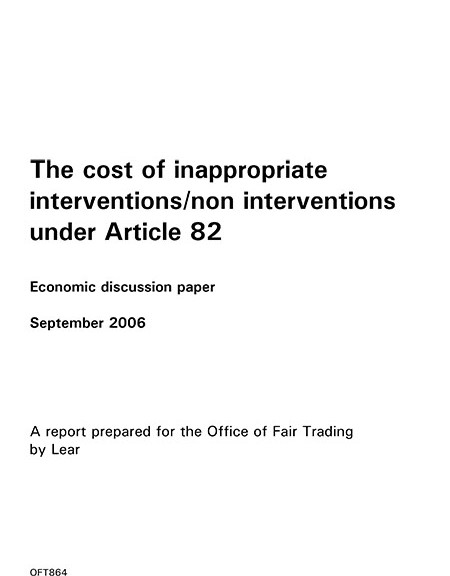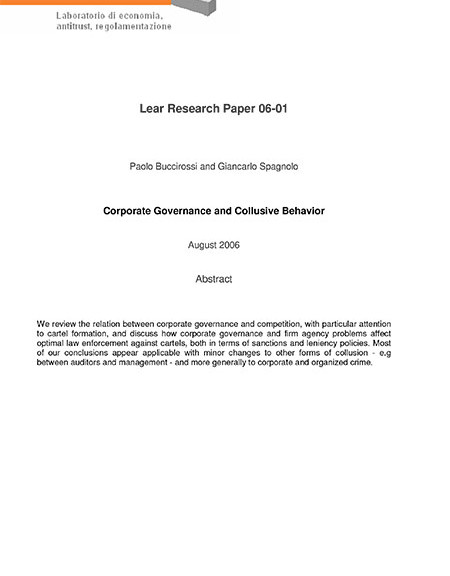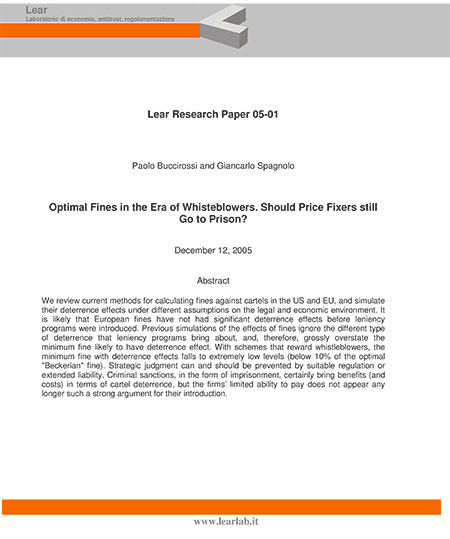This paper examines the optimal sanction for rules that are imperfect in that they are either overinclusive, as they prohibit an action that in some circumstances is beneficial, or underinclusive as they allow agents to undertake alternative conducts that are harmful, or both. The paper clarifies why this notion of imperfection divers from the notion of over- and underdeterrence and from that of legal errors. Finally it shows that when rules are imperfect the optimal sanction is lower than the optimal sanction for a perfect rule, both if the rule is overinclusive and if it is underinclusive.
Archives
Deterrence in Competition Law
This paper provides a comprehensive discussion of the deterrence properties of a competition policy regime. On the basis of the economic theory of law enforcement we identify several factors that are likely to affect its degree of deterrence: 1) sanctions and damages; 2) financial and human resources; 3) powers during the investigation; 4) quality of the law; 5) separation of power. We then discuss how to measure deterrence. We review independence and 6) the literature that uses surveys to solicit direct information on changes in the behavior of firms due to the threats posed by the enforcement of antitrust rules, and the literature based on the analysis of hard data. We finally argue that the most challenging task, both theoretically and empirically, is how to distinguish between “good” deterrence and “bad” deterrence.
Gesy- Discussion Paper n.285
Ex post review of merger control decisions
In this study prepared for the European Commission Lear proposes a methodology for the ex-post assessment of merger control decisions. The aim of the methodology is to establish whether the market structure arising from the decision protects social welfare better than the market structures that could have arisen from alternative decisions. The methodology also assesses whether the underlying economic analysis is correct and complete. The study then applies the proposed approach to the EU decision on the Pirelli and BICC merger.
Published by the European Commission (February 2007)
The cost of inappropriate interventions/non interventions under Article 82
The object of this research produced by the UK Office of Fair Trading (OFT) from LEAR is to improve the understanding of the costs of inappropriate competition authority (non) intervention in cases relating to abuse of dominance. A key aim is a greater understanding of these ‘error costs’ by type of abuse, industry characteristics and form of competition. The research proposes a new taxonomy of potentially abusive conducts and discusses how to asses their welfare effects, so as to minimize the costs of the errors which could be committed by a competition authority.
Published by the OFT (September 2006)
Leniency policies and illegal transactions
We study the consequences of leniency—reduced legal sanctions for wrongdoers who spontaneously self-report to law enforcers—on sequential, bilateral, illegal transactions, such as corruption, manager–auditor collusion, or drug deals. It is known that leniency helps deterring illegal relationships sustained by repeated interaction. Here we find that—when not properly designed—leniency may simultaneously provide an effective governance mechanism for occasional sequential illegal transactions that would not be feasible in its absence.
Corporate Governance and Collusive Behavior
Antitrust authorities often consider parallel pricing and market share stability to be clues of illegal collusion. To analyze whether this inference is correct, I develop a model of price competition with differentiated products in which demand and costs vary over time. In many cases parallel pricing does not distinguish between a competitive and a collusive outcome. However, in some cases perfect parallel pricing is compatible only with a competitive equilibrium, and therefore provides some evidence that firms did not collude. I also show that the competitive equilibrium is characterized by a higher market share stability than a collusive equilibrium.
Published in Review of Law & Economics: Vol. 2: No. 1, Article 5. (July 2006)
Does Parallel Behavior Provide Some Evidence of Collusion?
Antitrust authorities often consider parallel pricing and market share stability to be clues of illegal collusion. To analyze whether this inference is correct, I develop a model of price competition with differentiated products in which demand and costs vary over time. In many cases parallel pricing does not distinguish between a competitive and a collusive outcome. However, in some cases perfect parallel pricing is compatible only with a competitive equilibrium, and therefore provides some evidence that firms did not collude. I also show that the competitive equilibrium is characterized by a higher market share stability than a collusive equilibrium.
Published in Review of Law & Economics: Vol. 2: No. 1, Article 5. (July 2006).
Optimal Fines in the Era of Whisteblowers. Should Price Fixers still Go to Prison?
We review current methods for calculating fines against cartels in the US and EU, and simulate their deterennce effects under different assumptions on the legal and economic environment. It is likely that European fines have not had significant deterrence effects before leniency programs were introduced. Previous simulations of the effects of fines ignore the different type of deterrence that leniency programs bring about, and, therefore, grossly overstate the minimum fine likely to have deterrence effects falls to extremely low levels (below 10% of the optimal “Beckerian” fine). Strategic judgement can and should be prevented by suitable regulation or extended liability. Criminal sanctions, in the form of the imprisonment, certainly bring benefits (and costs) in terms of cartel deterrence, but the firms’ limited ability to pay does not appear any longer such a strong argument for their introduction.
Managerial Incentives and Collusive Behavior
I characterize the effects of empirically observed managerial incentives on long-run oligopolistic competition. When managers have a preference for smooth time-paths of profits – as revealed by the empirical literature on “income smoothing” – manager-led firms can sustain collusive agreements at lower discount factors. Capped bonus plans and incumbency rents with termination threats make collusion supportable at any discount factor, independent of contracts’ duration. When managers have these preferences/incentives and demand fluctuates, “price wars during booms” need not occur: the most collusive price may then be pro-cyclical.
Published in European Economic Review (July 2005), pages 235-254.
Competition in the Internet Backbone Market
This paper presents a competitive assessment of the global market for the provision of universal Internet connectivity (backbone market). We discuss the approach followed by the EC Commission in two important merger cases. The main argument is for a restless evolution of the structure of the market, whereby an highly concentrated US-centric industry, with a strict vertical hierarchy between Internet Service Providers and a neat separation between first-level ISPs and the rest of the market, is going to be superseded by a more horizontally shaped configuration. It is argued that, as the landscape of the industry is subject to continuous change, the approach followed by the EC Commission in assessing the competitive forces that drive the industry is likely to be no longer appropriate. New behavioral strategies, such as differentiation through the introduction of new enhanced Internet services based on the concept of Quality of Service, and, related to that, new competitive threats seem to characterize the foreseeable future of the Internet. We then investigate the competitive concerns that might emerge in the new environment.

